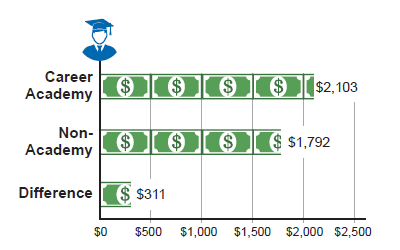Career Academies aim to make the high school experience more rigorous and relevant by creating supportive learning communities, integrating academic and career-focused curricula, and working with local employers to offer students exposure to jobs in demand.
Career Academies produced strong and sustained increases in students’ post-high school earnings. These impacts were concentrated among young men.
A well-conducted randomized controlled trial demonstrated that students who participated in Career Academies earned $174 more per month, on average, than students who participated in Non-Academy high school offerings, over the eight years following students’ scheduled high school graduation (Exhibit 1). These impacts were even higher for young men than for the full sample—an average of $311 more per month (Exhibit 2).
Exhibit 1: Average Monthly Earnings Eight Years After Scheduled Graduation

Source: Kemple & Willner 2008.
Note: The impact on average monthly earnings is statistically significant at the 5 percent level.
Exhibit 2: Average Monthly Earnings Eight Years After Scheduled Graduation, Young Men

Source: Kemple & Willner 2008.
Note: The impact on average monthly earnings is statistically significant at the 5 percent level.
Career Academies did not increase educational attainment.
There were no statistically significant differences between Career Academy and Non-Academy students in high school diploma, general equivalency degree (GED), or post-secondary credential attainment.
Implementing all three program components proved somewhat challenging.
According to the evaluation report, integrating academic and technical curricula proved to be a challenge. In addition, the relationships between the academies and local employers were more often leveraged to offer students career exposure than to offer them specific jobs. According to the implementation study associated with the evaluation, factors that affected implementation of Career Academies included availability of resources, the leadership ability of the Academy director, support from the school and school district, allocation of staff time to organize employers’ engagement and work placements, the extent of employers’ participation, and the articulation of a vision that connected program design with local employment needs.
Features of Career Academies
First established in 1969, Career Academies now operate in more than 7,000 schools nationwide. Students typically enter them as freshmen or sophomores in high school. Career Academies have three distinguishing features:
- They are organized as small learning communities, or schools-within-schools.
- The curriculum centers on one career, occupation, or industry and combines academic and technical aspects relevant to the career.
- They provide work-based learning experiences, often through partnerships with local employers. These can include summer employment, internships, and mentoring.
The following Career Academies were included in the randomized controlled trial evaluation:
- Business and Finance Academy, Pittsburgh, Pennsylvania
- Academy of Finance, Baltimore, Maryland
- Public Service Academy, Washington, D.C.
- Academy of Travel and Tourism, Miami Beach, Florida
- Health Professions Academy, Socorro, Texas
- Global Business Academy, Santa Ana, California
- Watsonville Video Academy, Watsonville, California
- Electronics Academy (Silver Creek), San Jose, California
- Electronics Academy (Independence), San Jose, California
